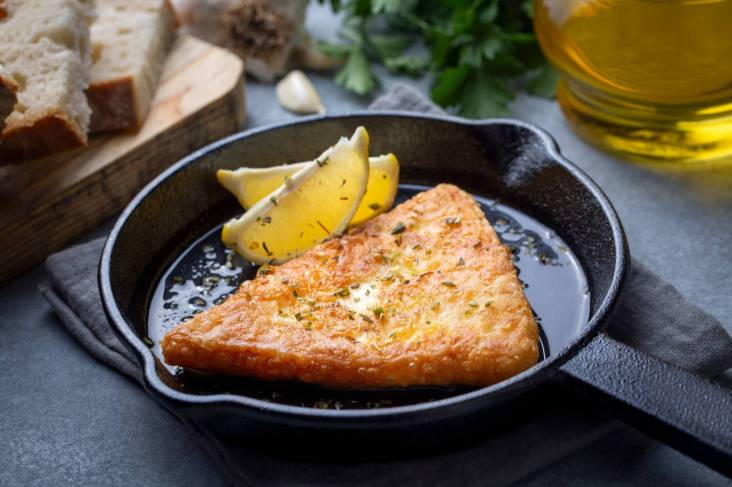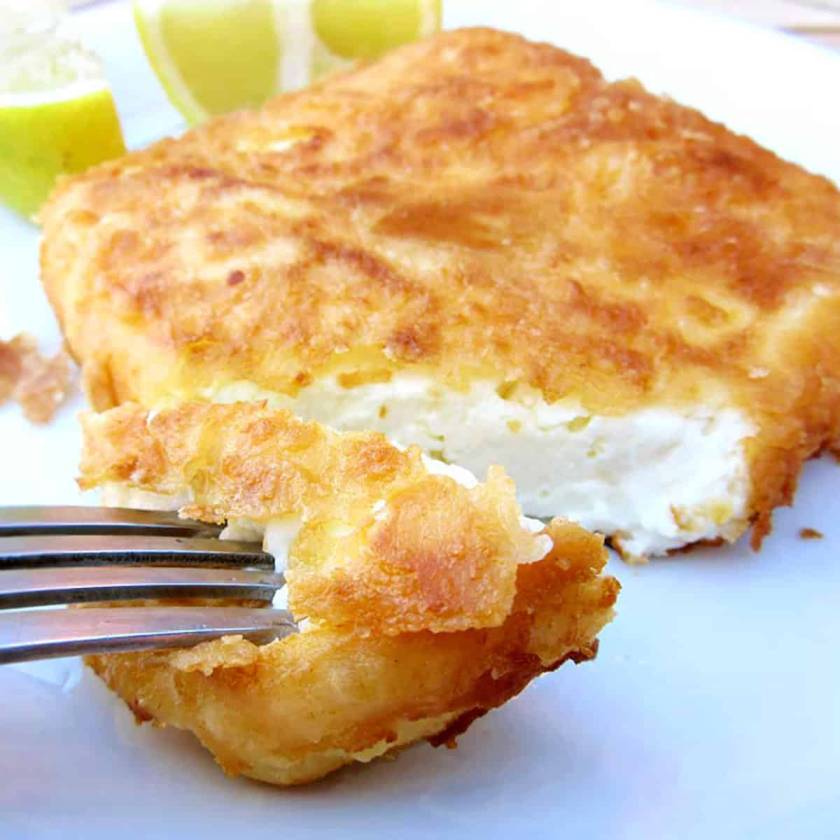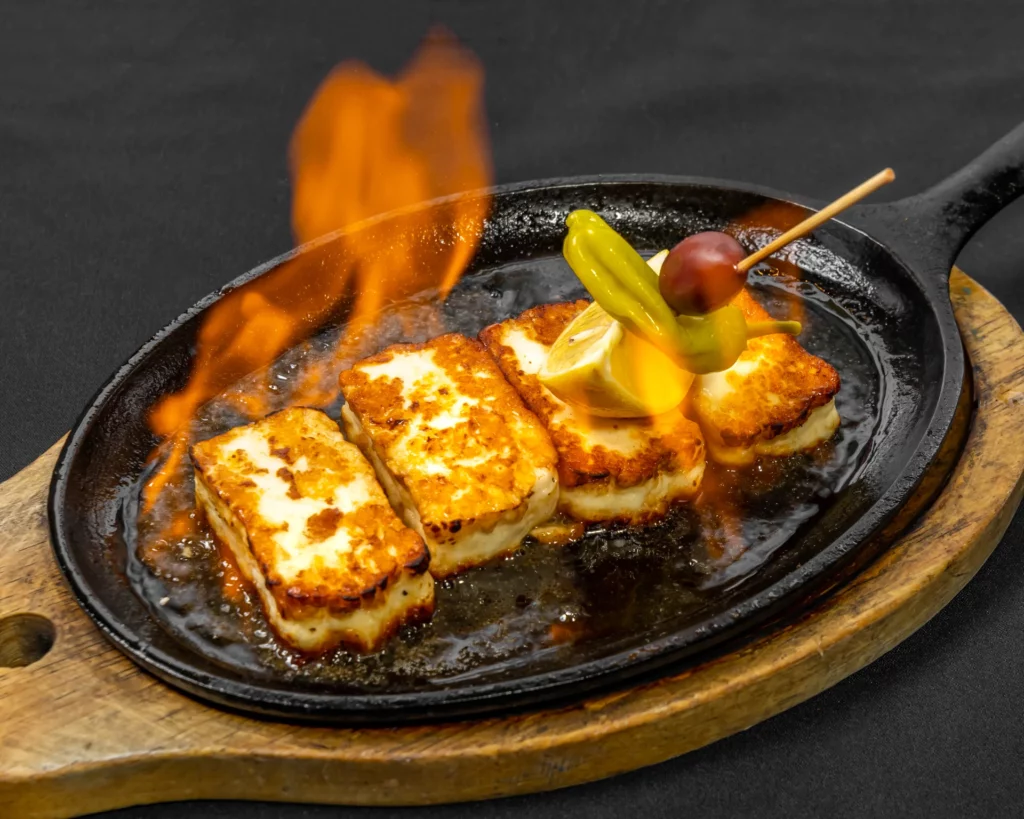What is Saganaki? The Greek Culinary Star

Dive into the heart of Greek gastronomy with a dish that is as simple as it is delicious: Saganaki. This culinary superstar, with its roots firmly planted in the vibrant culture and tradition of Greece, has transcended borders to become a favorite around the globe.
Saganaki is not just a dish; it’s an experience – a symphony of flavors and textures that perfectly encapsulates the boldness and richness of Greek cuisine. From the sizzling skillet it’s cooked in, to the flame-kissed cheese or seafood at its core, every aspect of Saganaki tells a story of age-old culinary traditions meeting modern desires for exciting, flavorful dishes.
Quick Facts About Saganaki
| Quick Facts | Details |
|---|---|
| Origin | Greece |
| Type | Appetizer |
| Main Ingredient | Cheese (commonly Kefalotyri, Kasseri, Graviera, or Halloumi) |
| Preparation | Cheese is lightly coated in flour, fried until golden in a small frying pan (saganaki), and served hot |
| Serving Style | Often flambéed at the table, extinguished with a squeeze of fresh lemon juice |
| Pairing | Commonly served with bread and can be accompanied by ouzo or tsipouro |
| Variations | Shrimp or Mussel Saganaki are popular seafood variations |
| Cultural Significance | A staple in Greek cuisine, commonly found in tavernas across the country |
| Taste | Savory and salty, with a crispy exterior and soft, melty interior |
| Nutritional Info | High in protein and calcium, but also high in sodium and fat due to the frying process |
What is Saganaki?

Saganaki, a name that resonates with Greek cuisine lovers worldwide, is a deliciously golden, pan-seared cheese dish known for its crispy exterior and gooey interior. The term ‘Saganaki’ refers to not just the dish but also the small two-handled heavy-bottomed frying pan used in its preparation. Named after the very utensil it’s cooked in, this appetizer holds a special place in the heart of Greek gastronomy.
This iconic Greek appetizer is typically made using a variety of Greek cheeses such as Kefalotyri, Kasseri, Graviera, or even the well-known Halloumi. One of the most popular versions involves frying Kasseri cheese, a semi-hard sheep milk cheese known for its salty, mild, nutty, and buttery flavor.
The magic of Saganaki lies in its preparation. The cheese is lightly dusted with flour and then fried until it turns a beautiful golden brown. But the theatrical element doesn’t end there. Often, it is flambeed at the table with a splash of brandy, and the flaming cheese is extinguished with a squeeze of fresh lemon juice. This ritual not only adds an air of spectacle to the dish but also enhances its flavor profile.
Served hot, Saganaki offers a tantalizing combination of textures and flavors – the crunch of its perfectly seared exterior giving way to the soft, melted cheese within. It’s a perfect appetizer, often enjoyed with bread and paired with ouzo or tsipouro. Besides the classic cheese version, there are several variations of Saganaki, including those featuring shrimp or mussels, showcasing the versatility of this Greek culinary tradition.
Whether you’re dining in a taverna in Greece or trying your hand at Greek cooking at home, Saganaki offers a true taste of Greek cuisine – simple ingredients, traditional cooking methods, and flavors that are anything but ordinary.
Saganaki Tasting Notes
- Cheese Flavor: Depending on the type of cheese used, Saganaki can have a range of flavors. Kefalotyri is robust and slightly tangy, Kasseri is mild and buttery, Graviera is nutty and sweet, and Halloumi is mild with a hint of mint.
- Texture: The dish is known for its dual texture – crispy and golden on the outside due to frying, while the inside becomes creamy and gooey as the cheese melts.
- Saltiness: Due to the cheese used, Saganaki has a distinct salty flavor which is characteristic of this dish.
- Savoriness: The combination of fried cheese and the slight caramelization that occurs during frying gives Saganaki a deep, savory taste.
- Acidity: A squeeze of fresh lemon juice over the top after cooking adds a light acidity that balances the rich, salty cheese.
- Heat: Saganaki is served hot, straight from the pan, enhancing the flavors and the overall eating experience.
- Pairing Notes: When paired with bread, the flavors are absorbed and balanced beautifully. The dish is also often served with ouzo or tsipouro, traditional Greek spirits that complement the rich, savory flavors of the cheese.
- Flambéed Effect: If flambéed at the table, the resulting slightly charred edges add an extra layer of complexity to the flavor profile of Saganaki.
What are the Different Types of Saganaki?
| Type of Saganaki | Description | Key Ingredients |
|---|---|---|
| Cheese Saganaki | This is probably the most famous type of Saganaki worldwide. A firm cheese is pan-fried until melty and often flambeed at the table. | Firm cheese (like Kasseri, Kefalotyri, or Halloumi), olive oil, lemon juice, and often ouzo or brandy for flambeing. |
| Shrimp Saganaki | A popular seafood dish in Greece, Shrimp Saganaki is a tomato-based stew with shrimp and feta cheese. | Shrimp, tomatoes, onions, garlic, feta cheese, olive oil, and sometimes a splash of ouzo. |
| Mussel Saganaki | Similar to Shrimp Saganaki but with mussels. The mussels are usually served in the shell in a tomato and feta sauce. | Mussels, tomatoes, onions, garlic, feta cheese, olive oil, and sometimes a splash of ouzo. |
| Meatball Saganaki | This version involves meatballs cooked in a rich tomato sauce and topped with melted cheese. | Ground meat, breadcrumbs, egg, spices, tomatoes, cheese, and olive oil. |
| Vegetable Saganaki | A less common but delicious variant, featuring vegetables cooked in a tomato sauce and topped with cheese. | Various vegetables, tomatoes, cheese, and olive oil. |
How to Eat Saganaki?

| Step | Description |
|---|---|
| Step 1: Preparation | Saganaki is usually served hot, straight from the pan. Ensure it’s served immediately after cooking for the best experience. |
| Step 2: Presentation | It’s traditionally presented in the pan it was cooked in. If it has been flambeed, the flames are extinguished with a squeeze of fresh lemon juice right before serving. |
| Step 3: Serving Size | Saganaki is a rich dish, so a small-to-medium portion is typically enough for one person. It’s often cut into bite-sized pieces for easy eating. |
| Step 4: Eating Utensils | It’s usually eaten with a fork and knife. Use the knife to cut smaller pieces if necessary. |
| Step 5: Accompaniments | Saganaki is often served with a side of fresh bread. The bread can be used to scoop up the cheese or to soak up the flavors left in the pan. |
| Step 6: Drink Pairings | Traditionally, it’s paired with ouzo or tsipouro, Greek spirits that complement the rich, savory flavors of the cheese. |
| Step 7: Additional Toppings | Some people like to add extra squeezes of lemon juice, or a sprinkle of fresh herbs like oregano or parsley, for additional flavor. |
| Step 8: Enjoy! | Savor the mixture of textures and the balance of flavors – the crispy, golden exterior and the gooey, melted cheese inside, combined with the tartness of the lemon juice. |
What is Saganaki made of?
- Cheese: The star ingredient of Saganaki is cheese. Traditional Greek cheeses like Kefalotyri, Kasseri, Graviera, or Halloumi are often used. Each cheese lends a distinct flavor to the dish.
- Flour: The cheese is typically lightly dusted with flour before frying. This helps to create a crispy, golden crust when fried.
- Olive Oil: Generally, olive oil is used for frying the cheese, adding to the rich flavor profile of the dish.
- Lemon Juice: After the cheese is fried, it’s commonly finished off with a squeeze of fresh lemon juice. This adds a light acidity that balances the rich, salty cheese.
- Optional Garnishes: While not always used, some recipes may call for garnishes like fresh herbs (such as oregano or parsley) or a sprinkling of freshly ground black pepper.
- Spirits for Flambé: Some variations of Saganaki involve flambeing the cheese with a splash of Brandy or Ouzo. This step is done at the table for a dramatic presentation and to add a slightly charred flavor.
- Bread: Though not part of the Saganaki dish itself, it’s often served with a side of fresh bread. The bread is perfect for scooping up the cheese and soaking up the flavors left in the pan.
What is the Difference Between Saganaki and Halloumi?
| Saganaki | Halloumi | |
|---|---|---|
| Definition | Saganaki refers to a variety of dishes prepared in a small frying pan, including cheese dishes. The name ‘saganaki’ is derived from the Greek word for ‘little frying pan’. | Halloumi is a specific type of cheese originating from Cyprus. It’s made from a combination of goat’s and sheep’s milk, and sometimes cow’s milk. |
| Usage | Saganaki can be made with various types of Greek cheeses, including graviera, kefalograviera, halloumi, kasseri, kefalotyri, or sheep’s milk feta cheese. | Halloumi cheese is often used in cooking because of its high melting point, which makes it perfect for grilling or frying. It’s commonly used in Cypriot, Greek, and Middle Eastern cuisine. |
| Taste & Texture | The taste and texture of saganaki depend on the type of cheese used. Generally, it has a crispy, golden exterior with a gooey, melted interior. | Halloumi has a unique texture that becomes squeaky when cooked due to its high melting point. It has a salty flavor profile. |
| Preparation | Saganaki cheese is typically lightly coated in flour and then fried in olive oil. Some versions are flambeed with a splash of spirits like Brandy or Ouzo. | Halloumi can be eaten raw, but it’s frequently grilled or fried due to its high melting point. |
In summary, Halloumi is a type of cheese that can be used in the preparation of Saganaki, among other cheeses. So, while Halloumi can be used to make Saganaki, not all Saganaki is made with Halloumi.
10 Best Saganaki Substitutes
| Substitute | Why It Works | Tasting Profile |
|---|---|---|
| 1. Halloumi | This cheese has a high melting point, making it an excellent substitute for frying or grilling. | Salty and slightly tangy with a distinctive squeaky texture when cooked. |
| 2. Kasseri | A traditional Greek cheese used in Saganaki, it melts well and holds its shape when fried. | Mildly salty with a semi-hard texture that becomes elastic when heated. |
| 3. Kefalotyri | Another traditional Greek cheese, it’s often used in Saganaki. It’s perfect for frying due to its hard texture. | Salty, sharp, and pungent with a hard, grating texture. |
| 4. Mozzarella | While not traditional, mozzarella can be used due to its ability to melt well and hold up to heat. | Mild and milky flavor with a stringy and stretchy texture when melted. |
| 5. Provolone | Its semi-hard texture and good melting properties make it a viable option. | Mild to sharp flavor depending on its age, with a smooth, elastic texture when melted. |
| 6. Gruyère | It’s a great melter and can withstand the heat of frying. | Nutty and slightly sweet, with a creamy, melting texture. |
| 7. Emmental | Known for its superb melting characteristics, it can be used as a substitute. | Mildly nutty and fruity with a smooth, melting texture. |
| 8. Jarlsberg | This cheese melts well and can hold up to the frying process. | Sweet and nutty with a smooth, melting texture. |
| 9. Manchego | While it doesn’t melt as well as some other options, it can still be used if you want a firmer result. | Nutty and caramel-like with a firm texture that softens slightly when heated. |
| 10. Queso de Bola | This Edam cheese from the Netherlands can be used due to its ability to withstand high heat. | Nutty and salty with a firm texture that becomes slightly softer when heated. |
What Pairs Well With Saganaki?

Food that goes well with Saganaki:
| Category | Food |
|---|---|
| Appetizers | Olives, Tzatziki (Greek yogurt dip), Hummus, Dolmades (stuffed grape leaves) |
| Breads | Pita bread, Sourdough, Baguette, Greek flatbread |
| Main Courses | Moussaka (Greek eggplant or potato-based dish), Souvlaki (Greek skewered meat), Greek salad, Grilled fish |
| Side Dishes | Greek roasted potatoes, Spanakopita (spinach pie), Greek rice pilaf, Greek-style green beans |
| Desserts | Baklava (sweet pastry), Loukoumades (Greek honey dumplings), Greek Yogurt with Honey and Walnuts, Galaktoboureko (custard in phyllo) |
Also read: 11 Best Crackers that Pair Well with Cheese
Beverage that goes well with Saganaki:
| Category | Beverage |
|---|---|
| Alcoholic | Ouzo (traditional Greek anise-flavored spirit), Tsipouro (Greek brandy), Greek white wines, Light-bodied red wines |
| Non-Alcoholic | Greek coffee, Lemonade, Iced tea, Sparkling water with a slice of lemon |
| Beer | Greek lagers, Light ales, Pilsners, Wheat beers |
| Wine | Assyrtiko (Greek white wine), Moschofilero (aromatic Greek white wine), Light-bodied Pinot Noir, Dry Rosé |
| Spirits | Metaxa (Greek spirit), Mastika (Greek liqueur), Dry Martini, Gin and Tonic |
Also read: Best Wine and Cheese Pairings: The Ultimate Guide
Also read:
- What is Cheddar Jack? The Art of Cheese Blending
- What is String Cheese? Everything You Need to Know
- What is Chihuahua Cheese? Mexican Cuisine’s Best Kept Secret
- What is Buche de Chevre? A French Culinary Treasure
- What is Fromage Frais? A French Culinary Gem Explained
- What is Ouleout? A Tale of Taste and Turmoil
- What is Hooligan Cheese? The Bold and the Beautiful




